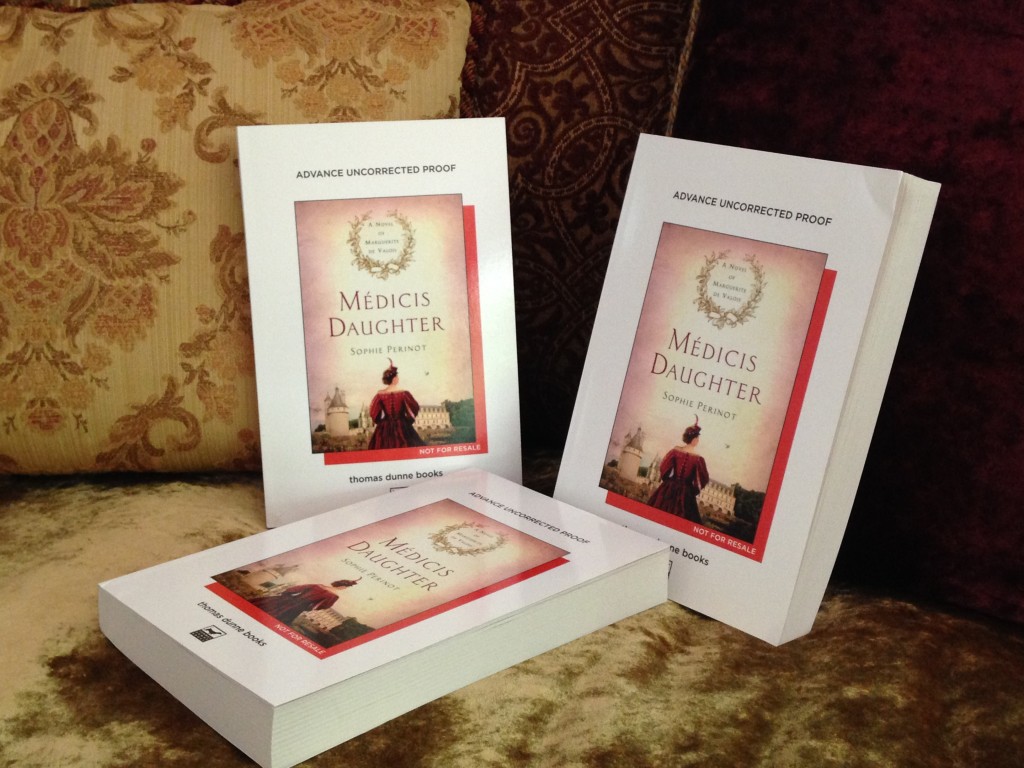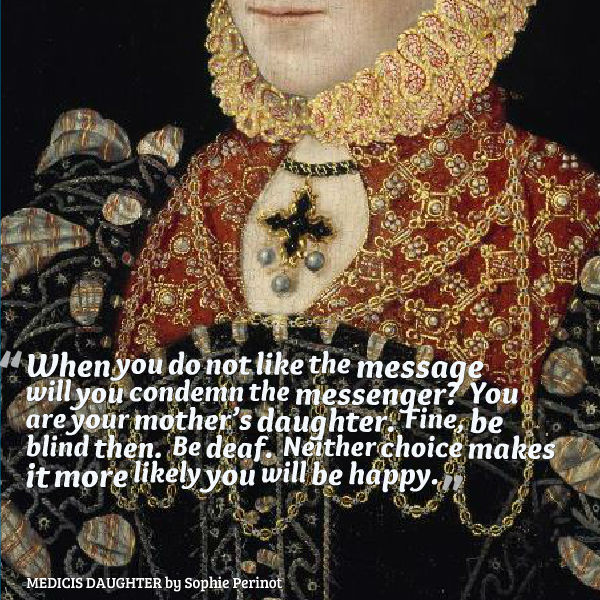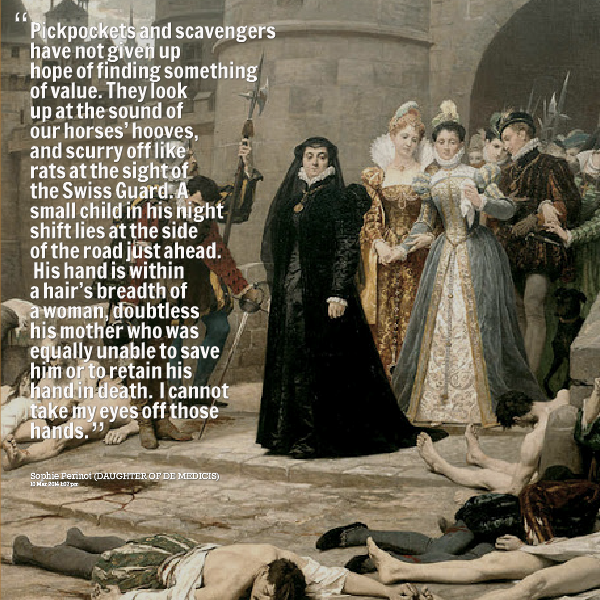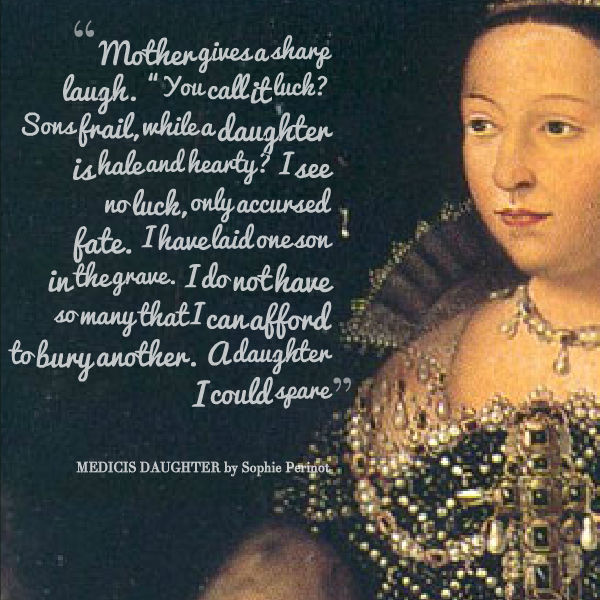Tag: Marguerite de Valois
Marguerite de Valois: Shinning a Light on a Much Maligned French Princess
Light is a frequent literary device. It can be an emblem of hope, a way to see what has been hidden, even a method of symbolically driving back demons. This month a collection of historical novelists, including myself, have decided to use light in all those ways, by creating a weekly blog event (#LightOnOurLadies) to illuminate the historical women at the center of our writings. The main character in my next novel, Médicis Daughter, is profoundly in need of such illumination. 
History has not been kind to 16th century French Princess Marguerite de Valois. In fact, she has been quite viciously misremembered as a wanton and a woman without substance. Before I explain how I think that happened, please allow me to shine a little light on the real Marguerite.
Born at the Château of Saint-Germain overlooking the Seine, as her father had been before her, Marguerite (or Margot as she was affectionately called) was the eighth child of King Henri II of France and Queen Catherine de Médicis. Described by the poet Ronsard as tall and graceful, with fine pale skin, sparkling black eyes, and chestnut hair, Margot stood out even at a Court renowned for its beauties. But she had more than looks going for her—far more. A true granddaughter of François I, Margot was highly intelligent. She loved books, and often got so swept away by them that she forgot to eat or sleep (sound familiar to anyone reading this?). As a mature woman, Margot was a serious and influential force in the literary life of France. A student of more than literature, Margot was a solid classics scholar. She spoke multiple languages fluently, and also had a genuine talent for public speaking. This she was frequently asked to do, often representing one royal brother or another. Finally Margot had a keen grasp of the fine points of statecraft. Arguably her political acumen exceeded that of her brothers, making her the most similar of all her siblings to her strong-willed, politically expert mother, Catherine de Médicis.
Why then, if Margot was as competent as she was pretty is she so little remembered? And when recalled, why is Margot depicted not as she was, but as lascivious and nearly amoral?
To put it simply, Marguerite de Valois was a victim of poor timing. She was born at the end of her dynasty.
When a royal house expires, its last years are generally recounted by people who have political and personal agendas that make it tempting to denigrate their predecessors. Such was the fate of Valois in the late 16th Century. Slander and denigration of royal family began during their lifetimes, largely fed by the tensions and rivalries of a vicious series of wars (the French Wars of Religion) that stretched from the early 1560s beyond the end of the Valois reign. No member of the Valois was exempt from the attacks of gossips, or from the writings of anonymous political pamphleteers. Anti-Valois propagandists seeking to degrade Marguerite chose that easiest and most ancient path for destroying a woman: assertions of rabid sexual desire and wanton conduct.
Slanderous talk about Margot began early among her family’s enemies, but she owes most of the lasting defamation of her character to a single printed work, Le divorce Satyrique. This malicious pamphlet was composed in her lifetime. It mocked and insulted Margot as it set out grounds for a proposed annulment of her marriage to Henri de Bourbon. Margot’s cousin/husband was no longer merely King of the Navarre, but King Henri IV of France—and a king in need of an heir. We all know that a King in need of an heir will do what it takes to be rid of a queen who cannot give him one. So, grounds for an annulment were created and printed. That such a piece of propaganda should have been taken up as fact and treated as history for so long may seem astounding to us today, but early chroniclers of the French court were often not particularly concerned with objectivity. Nor were early historians. As Robert Ja Sealy remarks in The Myth of the Reine Margot, “the documentary sources for our knowledge. . . were written during the wars of religion and, all too frequently are colored by political expediency . . .” Objectivity as a goal rather than a veneer is a rather recent requirement for history and historians. Even some of the histories written in the 19th and early 20th centuries make no pretense at objectivity in recounting the period of the Wars of Religion. Rather, their authors unabashedly announce in their prefaces which side they are on. Margot, considered not a particularly important historical player, remained largely unexamined. The myths about her grew and thrived in darkness.
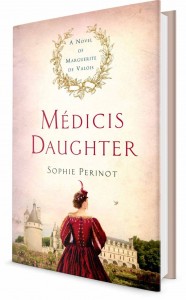 In Médicis Daughter I’ve focused a strong and clear light on the historical Marguerite, creating a coming-of-age story that does her better justice than she received from Valois disparagers, or from those later historians who saw no reason to look more closely. Médicis Daughter releases six weeks from today. To learn more about the book, visit the novel’s page at Amazon, or on Facebook.
In Médicis Daughter I’ve focused a strong and clear light on the historical Marguerite, creating a coming-of-age story that does her better justice than she received from Valois disparagers, or from those later historians who saw no reason to look more closely. Médicis Daughter releases six weeks from today. To learn more about the book, visit the novel’s page at Amazon, or on Facebook.
And now,
As part of the Shining Light on Our Ladies Tour, please meet my fellow authors Helen Hollick and Alison Morton… and their ladies
 Alison Morton is a woman after my own heart.
Alison Morton is a woman after my own heart.
Raised by a feminist mother and an ex-military father, it never occurred to Alison Morton that women couldn’t serve their country in the armed forces. After six years, she left as a captain, having done all sorts of interesting and exciting things she can’t talk about, even now…
Fascinated by the complex, power and value-driven Roman civilisation since childhood, she wondered what a modern Roman society would be like if run by strong women…
Alison lives in France and writes award-winning Roman-themed alternate history thrillers with tough Praetorian heroines – INCEPTIO, PERFIDITAS, SUCCESSIO and now
… AURELIA: Late in 1960s, Aurelia is sent to Berlin to investigate silver smuggling, former Praetorian Aurelia Mitela barely escapes a near-lethal trap. Her old enemy is at the heart of all her troubles and she pursues him back home to Roma Nova but he has struck at her most vulnerable point her young daughter. Please visit Alison (and Aurelia) to read more – and a chance to win a paperback copy of Aurelia
 Helen Hollick is a fierce advocate for Indie Authors.
Helen Hollick is a fierce advocate for Indie Authors.
She lives on a thirteen-acre farm in Devon, England. Born in London, Helen wrote pony stories as a teenager, moved to science-fiction and fantasy, and then discovered historical fiction. Published for over twenty years with her Arthurian Trilogy, and the 1066 era, she became a ‘USA Today’ bestseller with Forever Queen. She also writes the Sea Witch Voyages, pirate-based fantasy adventures. As a supporter of Indie Authors she is Managing Editor for the Historical Novel Society Indie Reviews, and inaugurated the HNS Indie Award.
On her blog today Helen introduces some ladies from the Court of King Arthur, except this ‘court’ is set in 5th century Britain and her Gwenhwyfar, Morgause and Morgaine are very different from the ladies of the Medieval tales!
ENJOYING THE SHINING LIGHT ON OUR LADIES TOUR? Then please join us again NEXT TUESDAY when we set sail with Captain Jesamiah Acorne’s ladies aboard Sea Witch, meet a lady surgeon disguised as a man aboard another ship, and are introduced to lady blackmailed into marrying a knight….
A Present for Me on Marguerite’s 462nd Birthday
Yesterday was Marguerite de Valois’ birthday.
Born in 1553 the protagonist of Médicis Daughter, as you will discover in my novel, was much more than history gives her credit for. I always think of her on her birthday and wonder “what if” (what if Salic law hadn’t prevented her from ruling in France when her last brother–Henri III–died? What if she’d be able to give her husband Henri IV a son?). I hope that in my novel I have given her a gift: a story that is worthy of her and undermines the pernicious rumors—started by political pamphleteers in her own time—that she was a wanton, a hedonist and not much more. So maybe my book is a birthday gift, belated but nonetheless . . .
Well yesterday I got a present: A box, perched atop my mailbox, containing the bound galleys of Médicis Daughter. They weren’t expected. They could have come any day. But they arrived on Marguerite’s birthday. A sign? I sure hope so!
Médicis Daughter Cover Reveal
Voila mes amis! I am very pleased and proud to introduce you to the visually stunning cover for my next novel, Médicis Daughter: A Novel of Marguerite de Valois. Yes, that is Marguerite in the forground and the goreous, iconic Chateau de Chenonceau in the background (a palace that is one of the settings from the book). What’s my favorite thing about it if I can’t say everything? The small, sinister, dark bird Margot is looking at in the sky. Psst, readers, keep an eye out for black birds as a recurring theme in the novel.
For those of you who are super eager, as of today you can pre-order Médicis Daughter on Amazon.
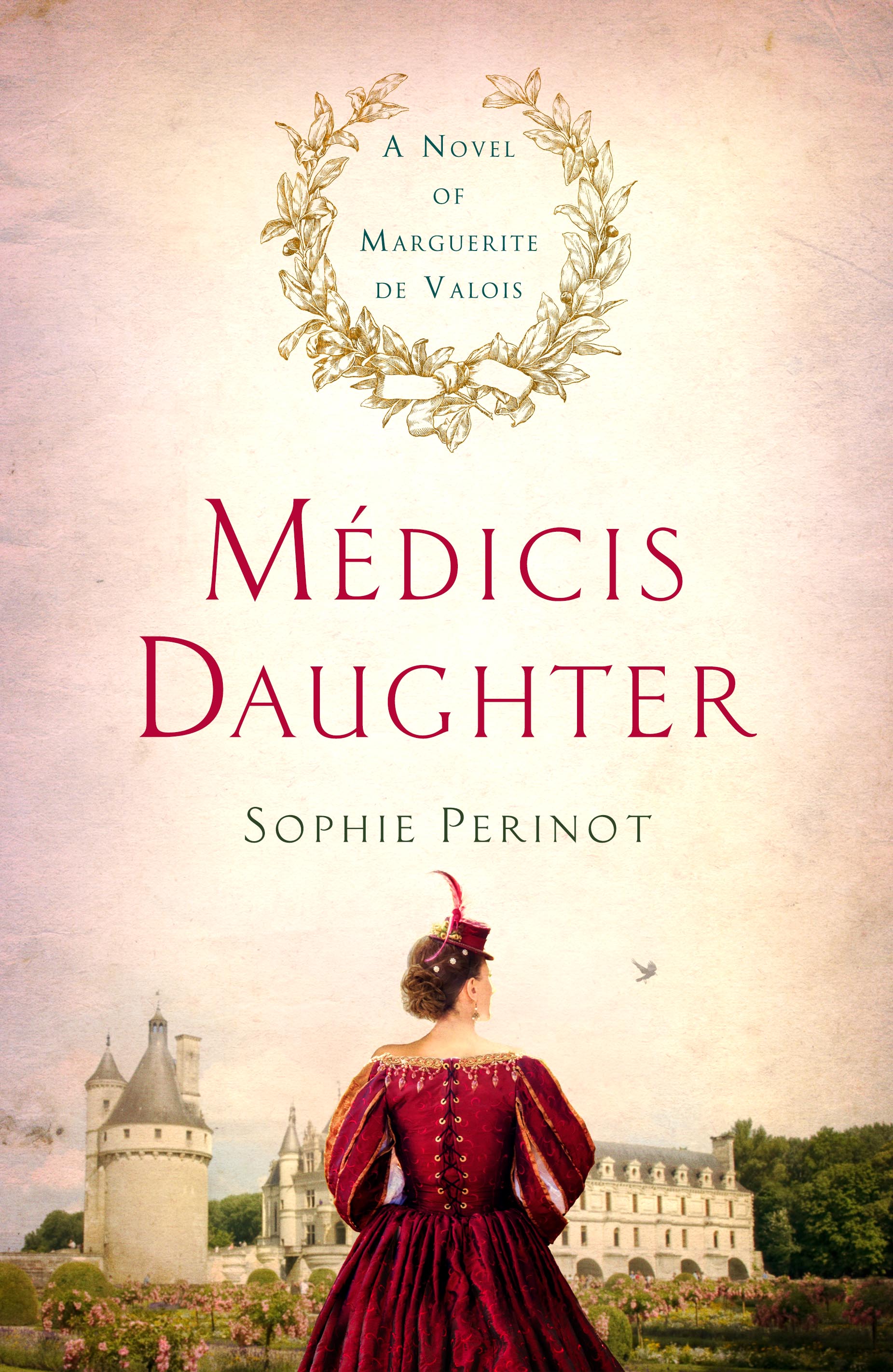
Médicis Daughter: an official announcement and an illustrated sneak-peek
It suddenly dawned on me, dear followers, that I have been negligent–I never announced the release date of my next novel here at the blog.
Médicis Daughter: A Novel of Marguerite de Valois will release on December 1, 2015 in hardcover. I have a fabulous new publisher (Thomas Dunne) and editor. What is the book about? So glad you asked! Here is a teaser:
Mother’s black eyes sparkle. “So, Margot, it seems you are a daughter of the Médicis as well the Valois.
16th Century France twists under the serpentine rule of Catherine de Médicis. At a court seething with intrigue and riven by religious war, beautiful Princess Margot walks the knife edge between the demands of her dangerous family, and the demands of her own conscience. Her chief value to the crown is as a pawn in the marriage game, to bring France a valuable ally or seal a tenuous peace. Even though her heart belongs to the powerful, charismatic Duc de Guise, her hand will be offered to the King of Navarre, heretic and rebel to the crown.
Margot does her duty, heart breaking, but the promised peace is a mirage: her mother’s schemes are endless, and her brothers plot vengeance in the streets of Paris. When Margot’s wedding devolves into the bloodshed of the St. Bartholmew’s Day massacre, she will be forced to choose: her family, or her soul?
The book is not yet available for pre-order, but you can add it to your “Want to Read” shelf at goodreads, and follow latest developments at the Médicis Daughter official facebook page. One of the things you will see a lot of there are illustrated quotes from the novel to whet your appetite. I’ve put three below just to tempt you over to facebook.
xo Sophie
Tagged: The Next Big Thing – Find Out What I am Working on Now
I’ve been tagged by the talented historical thriller writer Nancy Bilyeau (author of The Crown) in a blog game called The Next Big Thing. The game involves authors answering questions about their work in progress (aka WIP). So I am “it” for the moment, and I am off to the 16th century to talk about the mother-daughter story I am writing. Come along! Will my WIP be the next big thing? I sure hope so, but only readers can make that decision.
Here we go. . . my answers to the OFFICIAL “Ten Questions for The Next Big Thing”:
1. What is the working title of your book?
Daughter of de Medici
2. Where did the idea come from for the book?
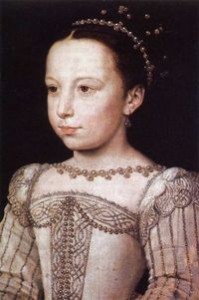
It sprang from the intersection between two strong personal interests. First, I have been fascinated with the Valois royal line since I read Alexandre Dumas’ book La Reine Margot as a teen, and I’ve been particularly obsessed with the oft maligned Marguerite de Valois, youngest daughter of Catherine de Medici and Henri II of France. Second, I have a preoccupation with the relationships that shape women’s lives—especially formative female-to-female relationships. Daughter of de Medici unites those two interests by exploring the sacred, complicated and oh-so-seminal mother-daughter relationship with Marguerite de Valois and Catherine de Medici as main characters.
3. What genre does your book fall under?
Historical fiction. I just can’t imagine writing about the present.
4. Which actors would you choose to play your characters in a movie rendition?
I would cast Keira Knightley to play Marguerite as she has both the beauty (Marguerite was often called the loveliest woman in France) and the depth for the role. If Keira was busy I’d cast Natalie Portman. I’d want Virna Lisi to play Catherine de Medici because she did a breathtaking job in that role in Patrice Chéreau’s 1994 film La Reine Margot.
As for the men in Marguerite’s life, I would cast Benedict Cumberbatch as Henri, Duc de Guise (Marguerite’s first love) or Robert Pattinson if Benny is deemed too old. I’d choose Joseph Gordon-Levitt as Marguerite’s older brother Henri, Duc d’Anjou (future Henri III of France) and Nicholas Hoult as her younger brother François, Duc d’Alençon. I am genuinely stumped on casting Henri de Navarre (Marguerite’s husband and the future Henri IV of France). I am sure the moment I post this I will think of THE perfect casting but for now I’d probably choose Jesse Eisenberg or Anton Yelchin.
5. What is the one-sentence synopsis of your book?
Not really a synopsis—more of a tag line: “Every mother-daughter relationship is fraught with peril. Her mother was Catherine de Medici.” Continue reading Tagged: The Next Big Thing – Find Out What I am Working on Now
